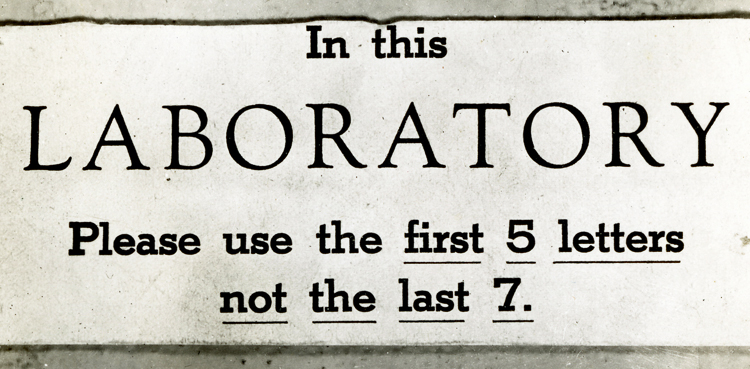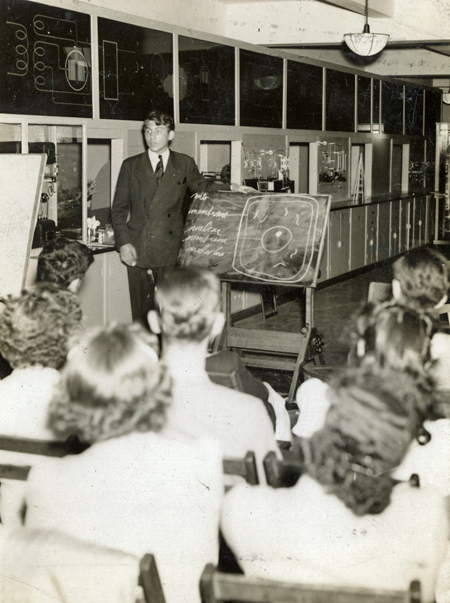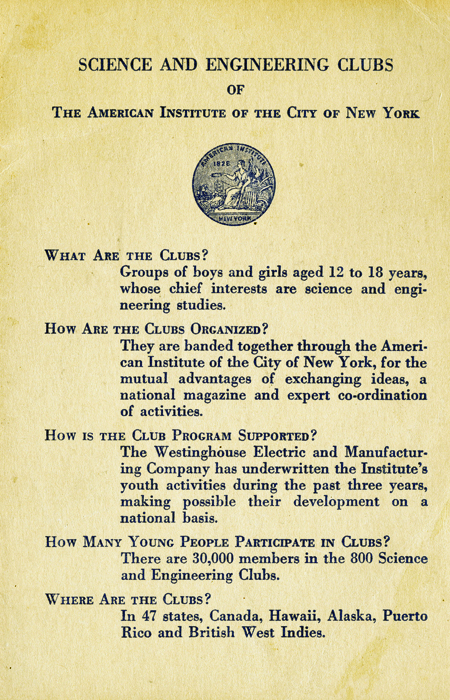The American Institute of the City of New York, founded in 1828, “encouraged and promoted domestic industry in this State, and the United States, in Agriculture, Commerce, Manufacturing and the Arts, and any improvements made therein." The Institute held regular expositions to encourage innovation, highlighted technical innovations and inventions, presented scientific lectures and demonstrations, and established a Children’s Science Fair in 1928.

Announcement of a Special Joint Meeting of the New York Electrical Society and the American Institute Science and Engineering Clubs, May 28, 1941. Courtesy of American Institute Science Laboratory Collection, Archives Center (AC1380-0000004)
One of the programmatic aims of the Institute was working with teachers in New York City to create science and engineering clubs for boys and girls, ages 12 to 18. By 1938, the Institute established a nationwide organization of clubs in the United States and Canada. Many clubs sought affiliation with the Institute and organized under its name. According to the New York Historical Society's Guide to the Records of the American Institute, “during the 1930's, the Institute developed relationships with two important corporate sponsors, Westinghouse and International Business Machines (IBM).”
With financial support from Westinghouse, the Institute sponsored an exhibit at the 1939–1940 New York World’s Fair featuring the work of New York City area students, with the intention that “visitors will realize the part which science club work is playing in the education of the youth of today and agree that science is indeed becoming a way of life.”1 At the close of the Fair, Westinghouse donated the fully-equipped science laboratory to the American Institute for use by students from New York City high schools. IBM provided space for the laboratory in midtown Manhattan at 310 Fifth Avenue. An early “makerspace,” the lab opened February 1, 1941 and was available to students to design, construct, experiment, and evaluate scientific or engineering problems and to receive guidance from an advisory board of scientists. Students had access to photographic darkrooms, chemistry and physics equipment, a radio workshop, and hydroponics and animal cages.

IBM Science Laboratory sign encouraging students to “labor” and not to engage in “oratory,” undated. Courtesy of American Institute Science Laboratory Collection, Archives Center (AC1380-0000006)
Henry Platt (1916–1999), a psychologist and science educator who directed the IBM Science Laboratory and later became an educational consultant for the Science Clubs of America/Science Service, developed national science fairs and the Westinghouse Science Talent Search. Platt had previously worked with students as the director of the Westinghouse Junior Hall of Science at the New York World’s Fair (1939–1940). The nurturing environment that Platt provided instilled confidence and motivation and, unknowingly, set the stage for work by future Nobel Laureates, innovators, and contributors in several scientific fields.

Joshua Lederberg lecturing about his cellular research to fellow students at the American Institute, about 1941. Courtesy of American Institute Science Laboratory Collection, Archives Center (AC1380-0000007)
Among some of New York’s talented high school students at the lab was Baruch Blumberg (1925–2011) of Far Rockaway High School, Queens. Blumberg’s research project in May 1941 explored “A Working Demonstration Model of a Gas Type Refrigerator.” Blumberg would become a physician and a co-recipient of the Nobel Prize in Physiology (1976) for his work on the hepatitis B virus. Joshua Lederberg (1925–2008), a graduate of Stuyvesant High School, worked on cellular research at the lab and would later graduate from Columbia and earn a Nobel Prize in Physiology (1958) for his work discovering that bacteria can mate and exchange genes. Lederberg said of the laboratory, “I would put the peer relationships as probably the most important aspect of that experience. These were a remarkable group of young people all deeply interested in science, enough so that they would devote all of their spare time to it.”2 He gave Henry Platt credit for fostering that collaborative atmosphere, saying, “[Pratt] was the guiding star of all that. He had not only conceived of the project, but he put it into practice, knew how to deal with us [students] in a positive, but skillful fashion. He was just the right mix of nurture and of discipline and I love that man.”3
After only a few months, however, the laboratory closed in August 1941 due to lack of funds. The Institute was unable to sustain the laboratory or its associated science fairs, which came under the organization of Science Service, Inc. Although short-lived, the laboratory provided the right mix of peer relationships for collaboration, mentor guidance, access to equipment, and the environment to explore self-directed research problems freely. The lab was ahead of its time, embracing the skill sets of critical thinking, problem solving, communication, and collaboration that are the hallmark of 21st century scientific research.

Brochure, Science and Engineering Clubs of the American Institute of the City of New York, May 28, 1941. Courtesy of American Institute Science Laboratory Collection, Archives Center (AC1380-0000005-01)
For more information about science education in the United States, visit the Archives Center where you can explore the Mr. Wizard Papers (documenting science educator Don Herbert, aka “Mr. Wizard”), the Bill Nye Papers (documenting Bill Nye, “the Science Guy”), and the American Institute of Science Laboratory Collection.
Notes:
1 American Institute of the City of New York brochure from the World’s Fair found in the American Institute of Science Laboratory Collection.
2 Lederberg transcript, American Institute Science Laboratory Collection.
3 Lederberg transcript, American Institute Science Laboratory Collection.
Sources:
Science, New Series, Vol. 89, No. 2300, January 27, 1939, p. 74.
Guide to the Records of the American Institute of the City of New York for the Encouragement of Science and Invention, 1808-1983 (Bulk 1828-1940), New York Historical Society.
Joshua Lederberg Papers, Letter from Henry Platt to Columbia University, August 26, 1941. Box 2, Folder 13. U.S. National Library of Medicine.
Terzian, Sevan G. “The 1939-1940 New York World’s Fair and the Transformation of the American Science Extracurriculum,” Science Education, 2008.


